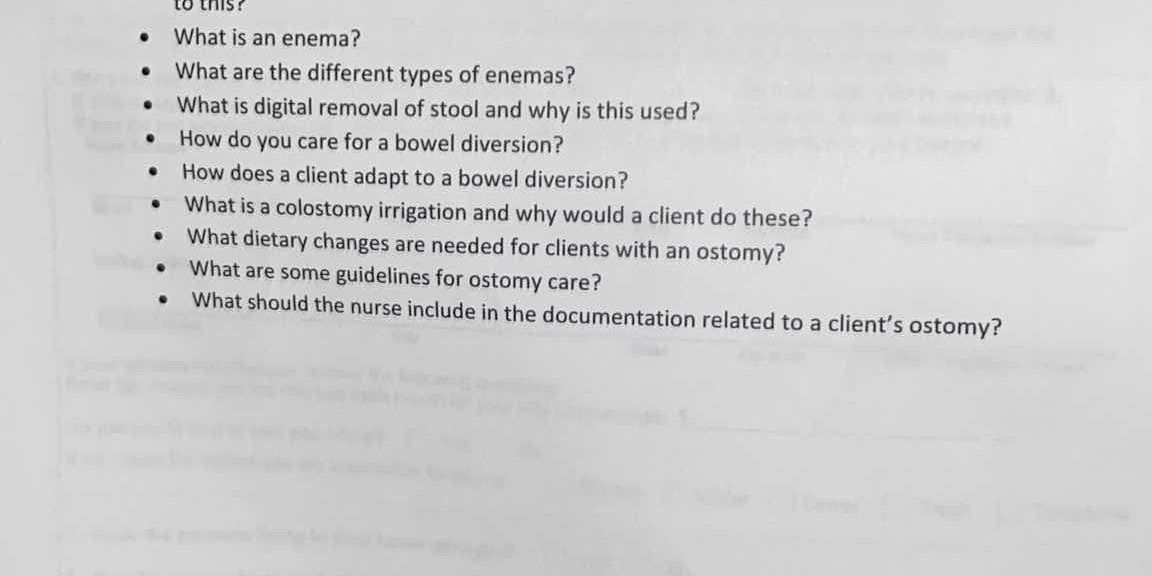What is an enema? What are the different types of enemas? What is digital removal of stool and why is this used? How do you care for a bowel diversion? How does a client adapt to a... What is an enema? What are the different types of enemas? What is digital removal of stool and why is this used? How do you care for a bowel diversion? How does a client adapt to a bowel diversion? What is colostomy irrigation and why would a client do these? What dietary changes are needed for clients with an ostomy? What are some guidelines for ostomy care? What should the nurse include in the documentation related to a client's ostomy?

Understand the Problem
The question presents a series of inquiries related to nursing care for bowel conditions, specifically focusing on enemas, bowel diversions, ostomy care, and dietary changes. It is likely for educational purposes, aimed at understanding patient management in nursing.
Answer
An enema introduces liquid into the rectum for bowel movements. There are cleansing, oil-retention, and medicated enemas. Digital removal is manual feces removal. Bowel diversion care involves stoma management. Colostomy irrigation regulates bowel movements. Dietary adjustments prevent issues. Documentation includes stoma and skin condition.
-
An enema is a procedure involving the insertion of liquid into the rectum to aid bowel movements.
-
Types of enemas include cleansing, oil-retention, and medicated enemas.
-
Digital removal of stool is the manual removal of impacted feces from the rectum, used when other methods fail.
-
Care for a bowel diversion involves skin protection, stoma care, and fluid balance monitoring.
-
Clients adapt to a bowel diversion by learning self-care techniques and emotional support.
-
Colostomy irrigation is a method of flushing out the colon through a stoma using water, done to regulate bowel movements.
-
Dietary changes for ostomy clients include eating low-fiber foods initially, ensuring hydration, and avoiding gas-producing foods.
-
Guidelines for ostomy care involve regular stoma and skin inspection, proper appliance fitting, and hygiene.
-
Ostomy documentation should include the appearance of the stoma, condition of the surrounding skin, output characteristics, and any client concerns or issues.
Answer for screen readers
-
An enema is a procedure involving the insertion of liquid into the rectum to aid bowel movements.
-
Types of enemas include cleansing, oil-retention, and medicated enemas.
-
Digital removal of stool is the manual removal of impacted feces from the rectum, used when other methods fail.
-
Care for a bowel diversion involves skin protection, stoma care, and fluid balance monitoring.
-
Clients adapt to a bowel diversion by learning self-care techniques and emotional support.
-
Colostomy irrigation is a method of flushing out the colon through a stoma using water, done to regulate bowel movements.
-
Dietary changes for ostomy clients include eating low-fiber foods initially, ensuring hydration, and avoiding gas-producing foods.
-
Guidelines for ostomy care involve regular stoma and skin inspection, proper appliance fitting, and hygiene.
-
Ostomy documentation should include the appearance of the stoma, condition of the surrounding skin, output characteristics, and any client concerns or issues.
More Information
Enemas can also be used for other medical purposes, such as administering medication directly to the bowel. Ostomy care is essential to prevent complications, such as skin irritation and infection.
Tips
When caring for a bowel diversion, ensure that the appliance is properly fitted to avoid leaks, and review dietary guidelines to prevent blockages or gas.
Sources
- Enema: What It Is, How It Works, Procedure, Benefits - my.clevelandclinic.org
- Colostomy Irrigation: Treatment, Definition & Causes - my.clevelandclinic.org
AI-generated content may contain errors. Please verify critical information